#Roman Insula
Explore tagged Tumblr posts
Text
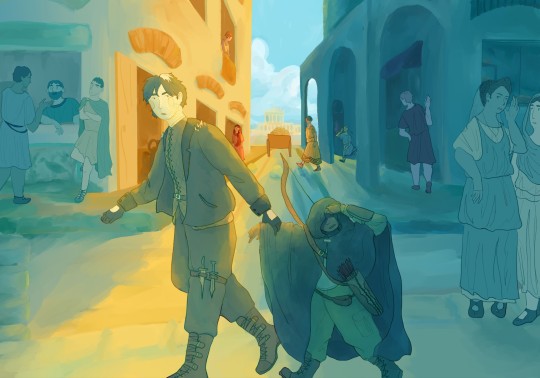
Everytime I listen to the Ancient Rome Sidequest it destroys me emotionally. But who knows, maybe somewhere there's a world where nothing terrible happens and it's just Sasha and Grizzop having fun adventures in ancient Rome.
#like Sasha and Grizzop stab Ceasar or they investigate a conspiracy around any prominent Roman guy#something like that#That's probably just me being nostalgic cause I read a lot of books like that as a kid#But I just want them to be okay and have some fun adventures together#The first episode of the sidequest was so much fun I need a fic where it just continues like that#I'd say I'd write that myself but it would probably become an ancient rome infodump#Anyway if anyone cares the window thing on the left belongs to one of those ancient roman “fast food” places#I saw a bunch of them in Pompeii and I think they're really cool#The painting on the wall below is also inspired by a fast food shop found there#The houses are supposed to be insulae which were apartment houses where most people were living#Those are your ancient rome funfacts for the day I guess#rusty quill gaming#rqg#rqg fanart#sasha rackett#sasha racket#grizzop drik acht amsterdam#fanart#art
99 notes
·
View notes
Text
IO SATURNALIA!

Here’s reallly a kind of last post before Christmas: an illustration I made a few years ago for CambridgeAmarantus.com - the FREE Cambridge Latin Course prequel made by CSCP (Caecilius est in horto), teaching ancient history and material culture through telling the story of Amarantus, freedman proprietor of the bar in Insula 1.9, in a research-based story by Caroline Lawrence (The Roman Mysteries).

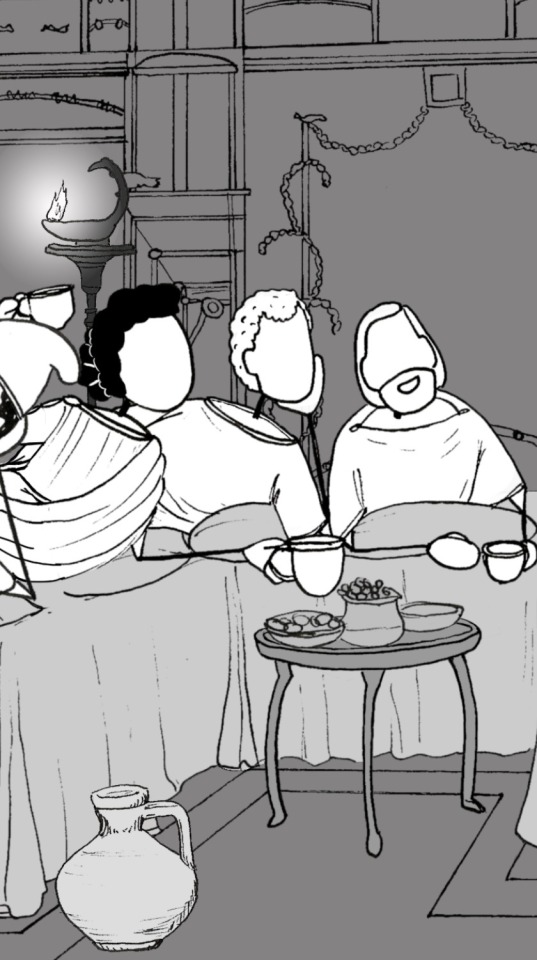
Here’s the end of the familia Saturnalia feast, Amarantus in his pileus cap playing panpipes and Coquus enjoying a bit of a rest. I loved putting all the little character details in, like puppy Potiscus getting a bone almost as big as himself, and the fabulous fresco background of the real-life triclinium!

I hope you all get a nice break and some lovely times over the holiday week. IO SATURNALIA! And thanks for liking my stuff x

And look out for *something else* coming on Boxing Day…
#io saturnalia#saturnalia#roman history#Roman religion#Pompeii#bar or Amarantus#insula 1.9#tagamemnon#illustration#art#Cambridge Amarantus
8 notes
·
View notes
Text
West drinking coffee > looking up the eating habits of Medieval Africans
A SINGLE LINE OF TEXT MADE ME REWRITE A GOOD CHUNK OF MY LORE! THANKS WEST! :D
#white men ruin everything /joking#I really REALLY didn’t like coffee machines existing in Glorious#And when I looked up ancient cooking techniques i came across Roman Insulas#And it all went down hill from there#I mean I’m glad Glorious is closer to my vision of being “Afro-Futuristic”#but like#all the old stuff i wrote with little tiny machines like that#In the same story Carlos orders a pizza and I have to desperately figure out what alternative he did instead#OH WAIT THEY DONT HAVE PERSONAL KITCHENS?! I HAVE TO REWRITE THAT WHOLE SCENE WITH NEW BLOCKING!!!#i’m unraveling#its bed time#no more lore hunting tonight#i’m not even gonna touch how I think computer are still okay in this story. it’s too much mental math to think about#basic idea: computers are living creatures and so are all robots
2 notes
·
View notes
Text
youtube
Did Roman apartment houses have a "Super" on site, or a doorman? Was parking included for your horse and wagon? What happened if your insula went condo? In this video you'll learn about Roman apartment houses, or insulae; who lived in an insula, and on what floors; the floor plan of a typical insula; and what a typical insula would have looked like.
#Rome#Roman#Ancient Rome#Ancient Roman#Insula#Insulae#Apartment#Aparment House#Condo#House#Housing#Urban Housing#High Rise#Tenant#Lease#Pompeii#Ostia#Tenement#Co-op#Family#Familia#Herculaneum#Domus#Domae#Villa#Residence#Penthouse#Poor#Poverty#Middle Class
20 notes
·
View notes
Text
Viața Cotidiană în Imperiul Roman: Pax Romana
Imperiul Roman timpuriu (27 î.Hr.–284 d.Hr.) a marcat o epocă de pace relativă, prosperitate economică și înflorire culturală, cunoscută adesea sub numele de Pax Romana. Pentru cetățeanul roman obișnuit, viața de zi cu zi era profund influențată de clasa socială, ocupație și locație, fie că trăia în orașele aglomerate, fie în mediul rural. Cu toate acestea, teme comune precum centralitatea…
#activitățile zilnice ale romanilor obișnuiți#agricultură#alimentația romanilor în antichitate#cena#Circus Maximus#clasele sociale din Imperiul Roman#Colosseum#diferențele între viața urbană și rurală în Roma antică#domus#filozofie.#forum#gladiatori#imperiul roman#insulae#Lares#moșii#ocupațiile cetățenilor romani obișnuiți#organizarea familiilor romane în antichitate#paterfamilias#patricieni#pax romana#Penates#plebei#prandium#rolul băilor publice în Roma antică#rolul religiei în viața romanilor antici#roma#roma antica#romani#sclavi
0 notes
Text
thinking about Ghost as a recently freed gladiator
(18+ for some explicit content at the end, also this is just some thoughts so may develop into something with more substance l8r lol)
part 1 part 2

Gladiator Ghost earns his freedom and sticks around Rome since he sure as shit doesn't want to go home, and wants to help train Soap and Gaz so they survive the Colosseum (like Price did with him).
But he's having trouble adjusting to freedom. Hell, he wears a toned-down version of his helmet in public. It keeps people at arm's length, but the stares follow him everywhere he goes. Better his stupid mask than his scarred face...
But now, he's stuck at a stall staring at two different types of olive oils that the vendor swears are popular choices (The oil that was given to the gladiators to clean themselves was some cheap, generic, crap, and he sure as shit doesn't know what they bought).
Suddenly, you crop up next to him, telling him not to buy that, and you whisk him to an upscale taberna and buy him a fancy little amphorae of olive oil as a celebratory gift for winning his freedom. "If you're hoping for anonymity, my dear Ghost, your fortune may improve if you leave your helm in the arena."
He barely had time to process before you disappeared into the crowd, leaving him with nothing but an I'll see you around the Colosseum.
But Ghost can't stop thinking of you.
Most Romans cowered before him. He's a massive brute who they've watched sow carnage and violence for years, he can hardly blame them. Watching a beast in a cage is amusing. Sharing a bathhouse with that same beast is something else.
You had been so soft and pretty, draped in expensive silk. You had been a brave little thing, walking right up to a known killer, but he had followed you like a dog.
He wants to sink his teeth into you.
He lets the oil you bought him run down his abs and drip onto his cock, stroking himself harshly. The oil feels luxurious on his skin, and a pleasant aroma wafts towards him. This was a quality product, must be why you liked it...
He's rough with himself, rougher than you would be. And his hands are calloused and tough. He imagines your head leaned against his thigh, one soft hand stroking his cock and the other fondling his balls.
He cums embarrassingly hard, letting his groans reverberate around his tiny apartment. The insulae was loud enough, his neighbors wouldn't care.
He dozes on his shitty bed, rubbing the mixture of oil and cum into his skin. It's gross, but he's been covered in worse. And he feels his cock twitch when his thoughts stray towards you again.
He'll nap, jack off again, and just clean up after.
Ghost hopes you meant it, that he'd see you at the Colosseum.
He's got every intention of fucking you if you'll let him. He'll gladly be your hound. He drifts off to thoughts of you riding him, your hand around his throat.

part 2
#simon riley x reader#ghost x reader#cod x reader#cod smut#ghost smut#simon riley smut#gladiator ghost
611 notes
·
View notes
Text

The Roman insula. The insula was the dwelling for the plebeians, originally resembling an island because it was separated from neighboring houses by a two-and-a-half-foot clearance
246 notes
·
View notes
Note
Hi Emma, I really need help for a script set in ancient times. I really don’t know where to start! I am not much of an historian but I really wanted to shift in Ancient Rome!

the ultimate guide to surviving ancient rome.
welcome, time traveler!!!!!!!! i'm emma. and i'll be helping you survive ancient rome. if you find yourself navigating the grandeur and grime of ancient rome, you'll need this comprehensive guide to thrive in an empire of marble, politics, and intrigue. from securing a place to stay to social etiquette, this will cover everything you need to know !!! so you don't die :)
where to start as you're entering rome??
arrival : if you're arriving from another part of the empire, the best entry points are ostia (rome's main port) or the via appia, a road leading directly to the city. the first thing you might see see will be a chaotic, sprawling metropolis of temples, markets, bathhouses, and crowded tenement buildings (insulae).
where to stay : if you're wealthy, you'll want to rent or buy a domus (townhouse) in the city. if you're less affluent (already sorry for you, not in a mean way but you won't last there long), an insula (apartment) in the subura district will suffice. though beware of fires and collapsing buildings ! xx
your hygiene and daily routines.
bathing : rome is famous for its public baths (thermae). visit places like the baths of caracalla or the baths of trajan. bring a small fee for entry and enjoy hot and cold plunges. don't forget oil and a strigil (a scraping tool) to clean off dirt. they, sadly, didn't have body lotion yet.
toilets and sanitation : rome has public latrines where people sit side by side (awkward but normal). a sponge on a stick (tersorium. yikes) is used instead of toilet paper, make sure to rinse it properly in running water, or you'll become the disgust of the city.
dental care : romans used powdered charcoal, crushed bones, and even urine (yes, really. look. it wasn't modern) to clean their teeth. bring your own mint leaves if you want to keep fresh breath without resorting to ammonia-based methods.
food and dining.
what to eat : the roman diet includes bread, olives, cheese, fruit, and fish. garum (fermented fish sauce) is a staple seasoning. wealthy romans dine on exotic meats like peacock and dormice. yep.
where to eat : If you're not cooking at home, stop by a thermopolium (a fast-food stand) for warm meals like stews and bread. not a mcdonalds, but it sufficed.
dining etiquette : reclining while eating is a sign of wealth. if invited to a noble's banquet, expect multiple courses, lively discussions, and perhaps some questionable entertainment (like performing dwarves or poetry recitals).
housing and shelter.
domus : wealthy residents live in lavish homes with atriums, mosaics, and private gardens. if you're in this category, hire slaves (SORRY. servants) to maintain the household.
insulae : these apartment buildings house most of rome's population. they're cheap but prone to fires, so always have an escape plan.
villas : if you want to escape city life, consider acquiring a countryside villa in places like campania or etruria.
personal safety.
crime : rome has a high crime rate, especially at night. avoid dark alleys, and keep a small dagger or hire a bodyguard (mercenarii) if you're wealthy.
fires : the city is prone to fires due to overcrowded wooden buildings. have an evacuation route and be aware of nearby water sources.
legal system : if you get into trouble, hire an orator to defend you in court. bribery is often the fastest solution to legal woes.
money and commerce.
the currency : the roman monetary system includes sestertii, denarii, and aurei (gold coins). always carry small change for daily expenses.
shopping : the forum is rome's commercial hub. you can buy anything from spices to togas. haggle, but not too aggressively, or you might offend the merchant. most things didn't have a tag, and the merchants would judge the price based on how you looked or talk. so. beware.
banking : rome has early banking institutions where you can store wealth. avoid keeping large sums on your person.
social class and interaction.
patricians vs. plebeians : social mobility is limited, but a well-connected plebeian can rise in status through military service or patronage.
slaves and freedmen : slavery was integral to roman society. freed slaves (liberti) can gain status, though they can remain linked to their former masters.
etiquette : addressing senators as "domine" (sir) and deferring to patricians in public are key social customs.
entertainment and leisure.
gladiatorial games : the colosseum hosts blood sports where slaves and prisoners fight to the death. betting on matches is common. vomiting in the stands..is also common.
chariot races : the circus maximus holds races between four factions: reds, blues, greens, and whites. pick a team and cheer them on.
theatre and oratory : if you have a sensitive stomach, enjoy performances at the theatre of pompey or listen to public speeches at the forum.
religion and temples.
gods and worship : romes pantheon includes jupiter, mars, venus, and more. each home has a household shrine (lararium) for daily offerings.
festivals : participate in saturnalia (a wild celebration where roles reverse and slaves feast like masters) or lupercalia (a fertility festival involving ritual sacrifices).
christianity : in early rome, christians were often persecuted. so. be discreet if practicing or associating with followers.
long-term survival...how do you are adapting to rome?
language : learn latin phrases. knowing greek is also helpful among the elite.
fashion : wear a tunic for daily life and a toga for formal occasions. women should drape themselves in stolas.
networking : find a patron for career advancement. political connections open a lot of doors in rome.

and that is this. if you survive, you're a guaranteed a cookie, albeit those didn't yet exist, i think. with this guide, you're well-equipped to navigate rome's splendour and chaos. whether you seek luxury, knowledge, or power, the eternal city awaits! pls don't die!
#asks#emmas vampire dr#shifting#reality shifting#shifting motivation#desired reality#realityshifting#shifting community#shifting realities#reality shift#shiftingrealities#shifting tips#shifting blog#shifting consciousness#shifting stories#shifting ideas#shifting reality#shifting antis dni#reality shifting community
265 notes
·
View notes
Text
More Roman Art Vocabulary

for your next poem/story
Denarius: the most common Roman silver coin.
Domus: a single-family house.
Encaustic: a painting technique in which heated wax was mixed with pigment. Used for the painting of mummy portraits in Roman Egypt.
Engaged column: a column set into the wall of a building so that only half projects.
Fasces: bundles of elm or birch rods bound together with an ax, used as a symbol of the magisterial power to punish.
Forum: the center of political and administrative activities in a Roman town. It was a large open space containing government buildings, markets, and temples.
Freedman: an emancipated slave with most rights of a citizen. Slaves could sometimes buy their way to the status of freedman, or they might be freed by their owner in his will. Children of freedmen were full citizens.
Fresco: a wall-painting technique in which the pigment is applied to newly plastered walls; the paint bonds with the plaster as both dry, creating a very durable surface.
Hypocaust system: a device used in Roman baths. The floor of a room to be heated was raised on small brick stilts, and then hot air from a central furnace was pumped under the floors to heat them. The heat would also rise up through the walls to heat the entire room.
Iconography: the meaning or symbolism of a work of art.
Imperator: general or commander, the root of the word “emperor.”
Insula: a Roman apartment house, usually with five or six stories. Several apartments on each floor surrounded a central courtyard. Often there were shops on the ground floor. The structures were usually built with brick-faced concrete.
Lararium: a shrine to the Roman household gods called lares. Every private home had one.
Lares: the Roman household gods.
Lenos: a sarcophagus shaped like a bathtub, with rounded corners.
Mosaic: patterns or pictures made by embedding small pebbles or pieces of stone or glass (tesserae) on floors or walls.
Necropolis: a “city of the dead”—a cemetery, always located outside the city walls.
Orchestra: the flat space in front of the stage building in a theater where the actors perform.
Papyrus: a plant that grows in the Nile River. Its fibers can be processed to make a form of writing paper that was used in Roman
Paterfamilias: the male head of a Roman family.
Source ⚜ More: Word Lists
#roman art#terminology#word list#writing inspiration#writeblr#dark academia#writing reference#spilled ink#light academia#creative writing#literature#writers on tumblr#poets on tumblr#writing prompt#poetry#writing resources
237 notes
·
View notes
Text

The insulae could be built up to nine storeys, before Augustus introduced a height limit of about 70 Roman feet (20.7 m). Later, this was reduced further, to about 60 Roman feet (17.75 m).[10][11] The notably large Insula Felicles or Felicula was located near the Circus Flaminius in Regio IX; the early Christian writer Tertullian condemns the hubris of multiple-story buildings by comparing the Felicles to the towering homes of the gods.[12] It is posited that a typical insula would accommodate over 40 people in only 3,600 sq ft (330 m2); however, an entire structure could comprise about six to seven apartments, each covering about 1,000 sq ft (93 m2) in floor area.[citation needed] The only surviving insula in Rome is the five storey Insula dell'Ara Coeli dating from the 2nd century AD, which is found at the foot of the Capitoline Hill.[13][14]
192 notes
·
View notes
Text
The name Islas Canarias is likely derived from the Latin name Canariae Insulae, meaning "Islands of the Dogs", perhaps because monk seals or sea dogs were abundant, a name that was evidently generalized from the ancient name of one of these islands, Canaria – presumably Gran Canaria. According to the historian Pliny the Elder, the island Canaria contained "vast multitudes of dogs of very large size".[25] The connection to dogs is retained in their depiction on the islands' coat-of-arms.
Other theories speculate that the name comes from the Nukkari Berber tribe living in the Moroccan Atlas, named in Roman sources as Canarii, though Pliny again mentions the relation of this term with dogs.[26]
The name of the islands is not derived from the canary bird; rather, the birds are named after the islands.
25 notes
·
View notes
Text
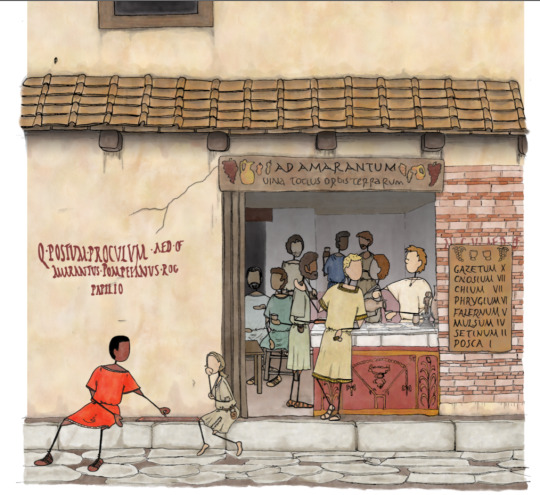

Between 2018-2021 I worked with archaeologist Dr Sophie Hay, Ancient Historian Prof. Andrew Wallace-Hadrill, Director of the Cambridge Schools Classics Project (who make the CLC Latin course!) Caroline Bristow and her gorgeous team, and legendary historical children’s fiction author Caroline Lawrence, to illustrate a novel and ancient history course about the life of Pompeiian freedman Amarantus and his neighbours in Insula 1.9
The story is a year in the life of Amarantus, following the events he experiences, including the devastating earthquake of 63BCE and his manumission (by a certain local natural-history-loving magistrate), the traditions of a Roman life, and the likely inhabitants of the rest of his block, based on the buildings and finds in Insula 1.9.
It acts as an Ancient History/Classical Civilisation (non-language) prequel to the Latin Caecilius stories (CLC Book 1) and there are some Caecilius-themed visual easter eggs 😁
The course has been designed for even non-specialists to be able to pick up and teach, entirely for free, to help bring Ancient History/Classics into schools.

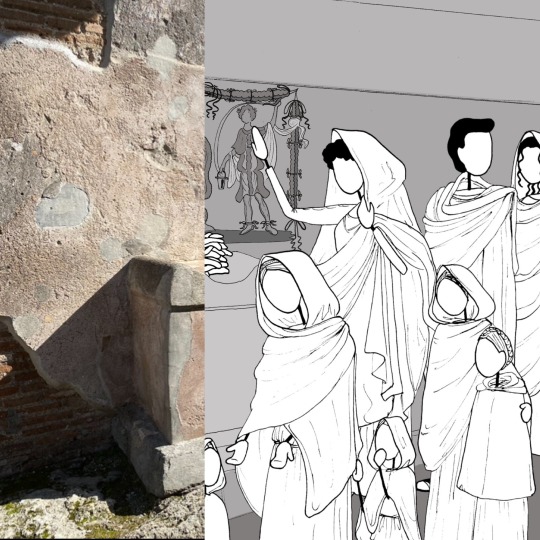
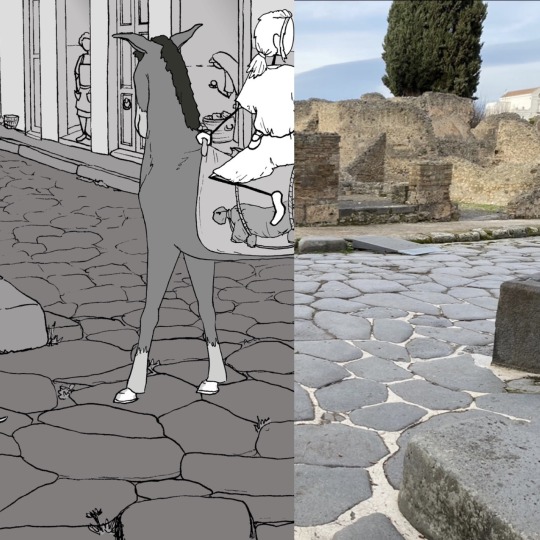
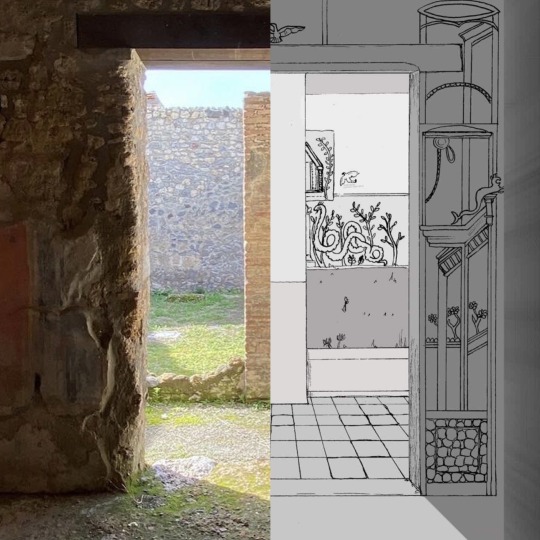
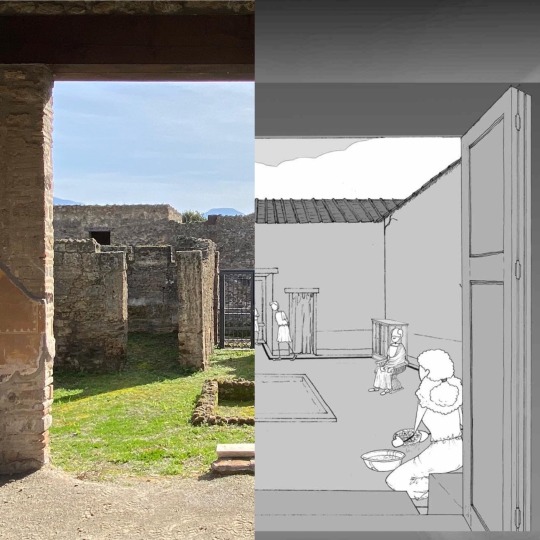
We made the images in grayscale so they could be cheaply printed and reproduced in PoD books/PDFs for schools, but made some images in full colour for the website and book cover to show the diversity of the Pompeiian world. They’re all based on archaeological evidence and research and each one took hours of discussion and argument (and occasional paper models) to get right. (And I’m proud to say my rebuilding of some ruined structures like the Herculaneum Gate has been approved by other Pompeii experts, like the Cooleys 😁)
The entire book and course is massively researched and based on archaeological findings, and is FREE on the CSCP website: https://CambridgeAmarantus.com/home
Or you can buy the book PoD via these links: https://www.cambridgescp.com/array/buy-book

Bonus Roman Chickens (the precursors to my Roman History Chickens series!): the cockfighters Odysseus and Polyphemus! (And yes cockfighting is terrible and I’m glad we don’t have it any more)
#roman history fandom#Roman history#historical fiction#archaeology#Pompeii#caecilius est in horto#CSCP#bar of Amarantus and his neighbours#amarantus#ancient history#teaching#teacher#classics teacher#classics teaching#tagamemnon#illustration#ancient history illustration#archaeological reconstruction#freebies#free education
340 notes
·
View notes
Text
British Isle Brothers headcanons. Includes several OCs. Presented in age order, with Celtic origins, originating clan name, human name, and some headcanon details.
Ireland - GAELIC [1] Īweriū, later Éire. Human name Cianán Ó Fionnagáin. Oldest brother, dark ginger hair and deep green eyes. He and Scotland used to be close, and share a distate for England. He didn't truly consider Britannia his mother, but he was close to her, and particularly cared for Scotland and Mann so still considers them as brothers. He thinks of England as a traitor for joining Rome, and then his subsequent conquering of the Isles, and distances himself from England as much as possible, even denying their brotherhood. Very, very angry about N. Ireland.
Scotland - GAELIC. [2] Epidion, earliest kingdom Dál Riata, became Alba. During Roman rule both he and Ireland's people were called Scoti, but it stuck with him. Human name: Alasdair Kirkland. Second oldest, dark red hair and deep green eyes. He and Pictland had a tumultuous brotherhood, until finally the Pict culture disappeared, partially subsumed into the Gaelic Scots. If he remembers Pictland, he doesn't talk about him. Fights with England constantly, and their relationship is characterised by anger and violence.
Wales - BRITTONIC [3] Ordowīces, first kingdom Wallia, finally Cymru. In Roman rule, Britannia Secunda. Human name: Emrys Kirkland. He was red-headed when younger, these days he's strawberry blonde. The country most thoroughly conquered by England, but fighting to regain his identity. He isn't as loud or abrasive against England as Scotland and Ireland are, and is the closest of the brothers to him, but that doesn't mean they are always friendly.
Cornwall - BRITTONIC [4] Dumnonia/Cornovia, later Kernow. In Roman rule, Britannia Prima. Human name: Daveth Kirkland. Looks very similar to Wales, but with slightly turquoise eyes thanks to close ties with Brittany and French influence. Almost entirely subsumed into England, however a revival of language and culture is now underway. Although bitter about his lack of independence, he is generally not violent in his requests for it. He brags a lot about "technically" not being under England's rule, as he functions more as a Duchy than a county.
Isle of Mann - BRITTONIC/GAELIC [5] Manaua/Insula Manavia, then Mannin. Human name: Illiam Kirkland. Although his people have lived on the Isle for centuries and he has been there since Roman rule, his identity became strongest after Gaelicisation. Previous Nation of the island was Ronaldsway, though none of the brothers knew him. Although he used to be considered Brythonic, invasion by Ireland caused Gaelicisation; he therefore more strongly resembles Ireland than Wales. He became somewhat independent in 1866, and is now a crown dependency like the Channel Islands. He's the shortest of the brothers thanks to the small size of his territory. He mostly keeps out of conflicts between his brothers.
England - BRITTONIC [6] Icinia, then Britannia Flavia, finally becoming Angleland/England. Human name: Arthur Kirkland. Youngest of the surviving Celtic brothers, he was one of the most resistant of the 'English' Celts to Roman rule before the death of Boudicca. Thanks to this he was one of the last surviving Celts of Britannia, and took on the role of Roman Britain once he was finally fully conquered. Due to several invasions over history he looks the most different to his brothers, with tawny blonde hair and lighter green eyes, but when young he looked more similar to his brothers. His relationships with his brothers are generally soured by his colonisation and suppression of their nations.
North Ireland - BRITISH [7] First Ulster, then Northen Ireland. Human name: Aidan Kirkland. Perhaps born in the 1860s following massive divide between Unionist and Nationalist Irish factions in Ulster, definitely present by 1880s, became truly established in the 1920s after the partition. He looks more similar to Scotland and England than Ireland, with pale red-blonde hair and Englands paler green eyes. Relations between the two Irish brothers are extremely tense, and North is the only one of the brothers not fighting against England's control which doesnt endear him much to them. He's close to England and considers Scotland well, though he doesnt always tolerate his distaste for England. North physically still appears as a teenager, around 16 years old.
7 notes
·
View notes
Text
Submitted via Google Form:
Since a lot of the desert is not very habitable, my world has a lot of underground buildings in the desert very high tech so that the natural land isn't very important. What do I need to consider for this?
Tex: Do you have a particular desert in mind with this question? There’s a fair amount of deserts that are inhabited already by flora and fauna, if not to a hundred percent coverage, such as the Great Basin desert, Kalahari Desert, and the deserts of Australia.
Deserts that have less flora and fauna, and are of the more popular imagination, such as the Sahara, Gobi Desert, and Syrian Desert, will have pockets of inhabitation around places like wadis, where there’s enough underground pooled water for migrational animals - including humans - to travel to and from. It’s not unusual to see water, and thus inhabitation, around mountainous regions in the desert, or by the borders of a desert where climate zones shift based upon geological features.
Humans have been living in and around the desert for a very, very long time (Wikipedia). Because of this, they’ve developed methods of surviving, and while it might not necessarily be an analogue to denser human populations like New York City that’s teeming with life and a focus of travel, a life is made.
Aridity isn’t necessarily the domain of traditional deserts, either - mountains are a good example of this, as are certain popular examples of civilizations in these areas. Petra is a popular example, home to the Nabataeans and geographically within modern-day Jordan. A notable mountain peak, Tian Shan, in Central Asia, was one of many places the Yuezhi people lived, who were nomadic and lived not only in the surrounding area but also across places like the Tarim Basin and the Tibetan Plateau. There’s a lot of examples of similar situations in other parts of the globe, so this is not an isolated event in human history.
Now, what is your definition of high tech? Skyscrapers? Internet? Something else? Lighting is something humans have had for a while, in the form of candles, hearths, and lamps, and we’ve more or less had an electrical grid in some places since the late 1880s (Wikipedia).
Plumbing has existed for thousands of years in some form for both fresh and wastewater (Wikipedia 1, Wikipedia 2), as has architectural features such as bridges (Wikipedia) and other types of architectural works (Wikipedia). Multi-story buildings have also existed for a while, notable in Roman insulae and Egyptian city of Fustat.
Telecommunications has existed in some form for about as long as human civilization has existed (Wikipedia), but electronic telecommunications began at about 1830-1840 (Wikipedia). I don’t know if you consider this sufficiently old or sufficiently modern, but the information is there for your perusal. Accordingly, the predecessor to the modern internet, ARPANET, was a multi-country project that began in the 1960s and established by the US Department of Defense - and computing hardware has a before and after historical split in technological advances at about the same time (Wikipedia).
What are your goals with this setting and this technology? What are the reasons that your society is living in such an area with such a climate, and what are they using the technology for? Are the communicating with people outside of this area? Is the technology completely isolated, for archival purposes, or is it interacted with on a regular or frequent basis? How much of this is aesthetic, and how much of it is part of a plot or culture?
Utuabzu: Historically, there have been several cultures in arid environments that favoured partly or wholly underground structures, from the Ancestoral Puebloans of the American South West, who sometimes built into the sides of canyons to the Derinkuyu Underground City in south-eastern Türkiye, to the modern town of Cooper Pedy in South Australia. These sites vary significantly in form and in motivation, with the Ancestoral Puebloan canyonside structures built primarily for defense, Derinkuyu built partly for defense and partly just because the local stone was really easy to carve through and vast underground spaces made for convenient storage, and Cooper Pedy is underground to mitigate the worst of the desert heat, mostly utilising exhausted opal mines.
Any or all of these reasons could apply, and would impact your setting’s architecture and urban forms, but the biggest impact is always going to come from the reason people started living there in the first place. The Ancestoral Puebloans farmed the fertile river valleys, Derinkuyu lies in Cappadokia, a region that once gave rise to the Hittite Empire and has plenty of decent farmland and pasture, while Cooper Pedy is a major centre for opal mining.
I’d suggest considering why this culture lives in the desert in the first place, and then researching what similar locations in the real world look like. Also, decide what sort of desert you’re working with. As Tex said, there’s a lot of different kinds of desert, and they have historically produced very different cultures and architectural traditions. What makes sense in the hot sandy deserts of the Arabian Peninsula or Northern Africa does not necessarily make sense in even the relatively nearby Iranian Plateau or Thar Desert, let alone the cold deserts of Central Asia or the high altitude Atacama or Tibetan Plateau.
11 notes
·
View notes
Link
As elsewhere, whether on a farm or in the city, daily life still centered on the home, and when people arrived in the city, their first concern was to find a place to live. Space was at a premium in a walled metropolis like Rome, and from the beginning little attention was paid to the housing needs of the people who migrated to the city - tenements provided the best answer. The majority of Roman citizens, not all of them poor, lived in these apartment buildings or insulae. As early as 150 BCE, there were over 46,000 insulae throughout the city. LEARN MORE --> https://www.youtube.com/watch?v=47RPlvgi2VQ
34 notes
·
View notes
Text

Insieme agli scavi di San Clemente, le Case romane del Celio rappresentano uno dei luoghi più affascinanti della Roma sotterranea per la presenza di decorazioni originali e per le vicende che nei secoli hanno inciso profondi cambiamenti alla struttura
La straordinarietà dello stato di conservazione degli ambienti affrescati e l’altissimo valore artistico e di interesse religioso fanno delle Case romane del Celio una tappa fondamentale nella conoscenza della Roma antica.
Note anche come la "casa dei martiri Giovanni e Paolo", racchiudono oltre quattro secoli di storia e testimoniano il passaggio e la convivenza tra paganesimo e cristianesimo.
I vasti ambienti interni, in origine botteghe e magazzini di un edifico popolare a più piani (insula), furono infatti trasformati nel corso del III sec. d.C. in un’elegante domus. Qui è possibile ammirare alcuni tra gli affreschi più belli di età tardo-antica.
3 notes
·
View notes